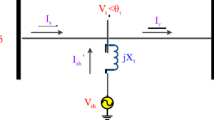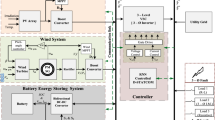Abstract
China is vigorously promoting the “whole county promotion” of distributed photovoltaics (DPVs). However, the high penetration rate of DPVs has brought problems such as voltage violation and power quality degradation to the distribution network, seriously affecting the safety and reliability of the power system. The traditional centralized control method of the distribution network has the problem of low efficiency, which is not practical enough in engineering practice. To address the problems, this paper proposes a cluster voltage control method for distributed photovoltaic grid-connected distribution network. First, it partitions the distribution network into clusters, and different clusters exchange terminal voltage information through a “virtual slack bus.” Then, in each cluster, based on the control strategy of “reactive power compensation first, active power curtailment later,” it employs an improved differential evolution (IDE) algorithm based on Cauchy disturbance to control the voltage. Simulation results in two different distribution systems show that the proposed method not only greatly improves the operational efficiency of the algorithm but also effectively controls the voltage of the distribution network, and maximizes the consumption capacity of DPVs based on qualified voltage.
Similar content being viewed by others
References
Bonthagorla P K, Mikkili S, Optimal P V. Array configuration for extracting maximum power under partial shading conditions by mitigating mismatching power losses. CSEE Journal of Power and Energy Systems, 2022, 8(2): 499–510
Swenson R. The solar evolution: Much more with way less, right now—The disruptive shift to renewables. Energies, 2016, 9(9): 676
Martins F, Felgueiras C, Smitkova M, et al. Analysis of fossil fuel energy consumption and environmental impacts in European countries. Energies, 2019, 12(6): 964
Wang S C. Current status of PV in China and its future forecast. CSEE Journal of Power and Energy Systems, 2020, 6(1): 72–82
Ahadi A, Miryousefi Aval S M, Hayati H. Generating capacity adequacy evaluation of large-scale, grid-connected photovoltaic systems. Frontiers in Energy, 2016, 10(3): 308–318
Shahsavari A, Akbari M. Potential of solar energy in developing countries for reducing energy-related emissions. Renewable & Sustainable Energy Reviews, 2018, 90: 275–291
Singla P, Duhan M, Saroha S. A comprehensive review and analysis of solar forecasting techniques. Frontiers in Energy, 2022, 16(2): 187–223
Lu Q, Yu H, Zhao K L, et al. Residential demand response considering distributed PV consumption: A model based on China’s PV policy. Energy, 2019, 172: 443–456
Liu S Y, Bie Z H, Liu F, et al. Policy implication on distributed generation PV trading in China. Energy Procedia, 2019, 159: 436–441
Wu Y N, Xu M J, Tao Y, et al. A critical barrier analysis framework to the development of rural distributed PV in China. Energy, 2022, 245: 123277
Gandhi O, Kumar D S, Rodriguez-Gallegos C D, et al. Review of power system impacts at high PV penetration Part I: Factors limiting PV penetration. Solar Energy, 2020, 210: 181–201
Chen J L, Xu X Y, Yan Z, et al. Data-driven distribution network topology identification considering correlated generation power of distributed energy resource. Frontiers in Energy, 2022, 16(1): 121–129
Zhang Y J, Qiao Y, Lu Z X, et al. Voltage control for partially visible distribution networks with high DG penetration. Power System Technology, 2019, 43(5): 1528–1535
Camilo F M, Almeida M E, Castro R, et al. Multi-conductor line models for harmonic load-flow calculations in LV networks with high penetration of PV generation. Journal of Modern Power Systems and Clean Energy, 2022, 10(5): 1288–1301
Hashemi S, Ostergaard J. Methods and strategies for overvoltage prevention in low voltage distribution systems with PV. IET Renewable Power Generation, 2017, 11(2): 205–214
Nour A M M, Hatata A Y, Helal A A, et al. Review on voltage-violation mitigation techniques of distribution networks with distributed rooftop PV systems. IET Generation, Transmission & Distribution, 2020, 14(3): 349–361
Xu J, Fu H B, Liao S Y, et al. Demand-side management based on model predictive control in distribution network for smoothing distributed photovoltaic power fluctuations. Journal of Modern Power Systems and Clean Energy, 2022, 10(5): 1326–1336
Jamal T, Urmee T, Calais M, et al. Technical challenges of PV deployment into remote Australian electricity networks: A review. Renewable & Sustainable Energy Reviews, 2017, 77: 1309–1325
Yang A Q, Cai Y X, Chen X P, et al. An adaptive control for supporting village power grid integrating residential PV power generation. Energy Reports, 2022, 8: 3350–3359
Li Q R, Zhang J C. Solutions of voltage beyond limits in distribution network with distributed photovoltaic generators. Automation of Electric Power Systems, 2015, 39(22): 117–123 (in Chinese)
Wang Y, Wen F S, Zhao B, et al. Analysis and countermeasures of voltage violation problems caused by high-density distributed photovoltaics. Proceedings of CSEE, 2016, 36(5): 1200–1206 (in Chinese)
Wang C L, Tao Y G. Locally and globally optimal solutions of global optimisation for max-plus linear systems. IET Control Theory & Applications, 2022, 16(2): 219–228
Zhao B, Xu Z C, Xu C, et al. Network partition based zonal voltage control for distribution networks with distributed PV systems. IEEE Transactions on Smart Grid, 2018, 9(5): 4087–4098
Chai Y Y, Guo L, Wang C S, et al. Network partition and voltage coordination control for distribution networks with high penetration of distributed PV units. IEEE Transactions on Power Systems, 2018, 33(3): 3396–3407
Ding J J, Zhang Q, Hu S J, et al. Clusters partition and zonal voltage regulation for distribution networks with high penetration of PVs. IET Generation, Transmission & Distribution, 2018, 12(22): 6041–6051
Cao D, Zhao J B, Hu W H, et al. Attention enabled multi-agent DRL for decentralized Volt-VAR control of active distribution system using PV inverters and SVCs. IEEE Transactions on Sustainable Energy, 2021, 12(3): 1582–1592
Liu L J, Zhang Y, Da C, et al. Optimal allocation of distributed generation and electric vehicle charging stations based on intelligent algorithm and bi-level programming. International Transactions on Electrical Energy Systems, 2020, 30(6): e12366
Sun J, Xu J, Ke D P, et al. Cluster partition for distributed energy resources in Regional Integrated Energy System. Energy Reports, 2023, 9: 613–619
Newman M E J. Fast algorithm for detecting community structure in networks. Physical Review E: Statistical, Nonlinear, and Soft Matter Physics, 2004, 69(6): 066133
Newman M E J. Modularity and community structure in networks. Proceedings of the National Academy of Sciences of the United States of America, 2006, 103(23): 8577–8582
Deng L B, Sun H L, Zhang L L, et al. η code: A differential evolution with η Cauchy operator for global numerical optimization. IEEE Access: Practical Innovations, Open Solutions, 2019, 7: 88517–88533
Qian J, Wang P, Chen G G. Improved gravitational search algorithm and novel power flow prediction network for multi-objective optimal active dispatching problems. Expert Systems with Applications, 2023, 223: 119863
Wagle R, Sharma P, Sharma C, et al. Optimal power flow based coordinated reactive and active power control to mitigate voltage violations in smart inverter enriched distribution network. International Journal of Green Energy, 2023: 1–17
Acknowledgements
This work was supported by the National Key R&D Plan Program of China (Grant No. 2022YFE0120700), the Special Fund for Science and Technology Innovation of Jiangsu Province (Grant No. BE2022610), and Zhuhai Industry Core Technology and Key Project (Grant No. 2220004002344).
Author information
Authors and Affiliations
Corresponding author
Ethics declarations
Competing interests The authors declare that they have no competing interests.
Rights and permissions
About this article
Cite this article
Zhang, J., Wang, T., Chen, J. et al. Cluster voltage control method for “Whole County” distributed photovoltaics based on improved differential evolution algorithm. Front. Energy 17, 782–795 (2023). https://doi.org/10.1007/s11708-023-0905-8
Received:
Accepted:
Published:
Issue Date:
DOI: https://doi.org/10.1007/s11708-023-0905-8




